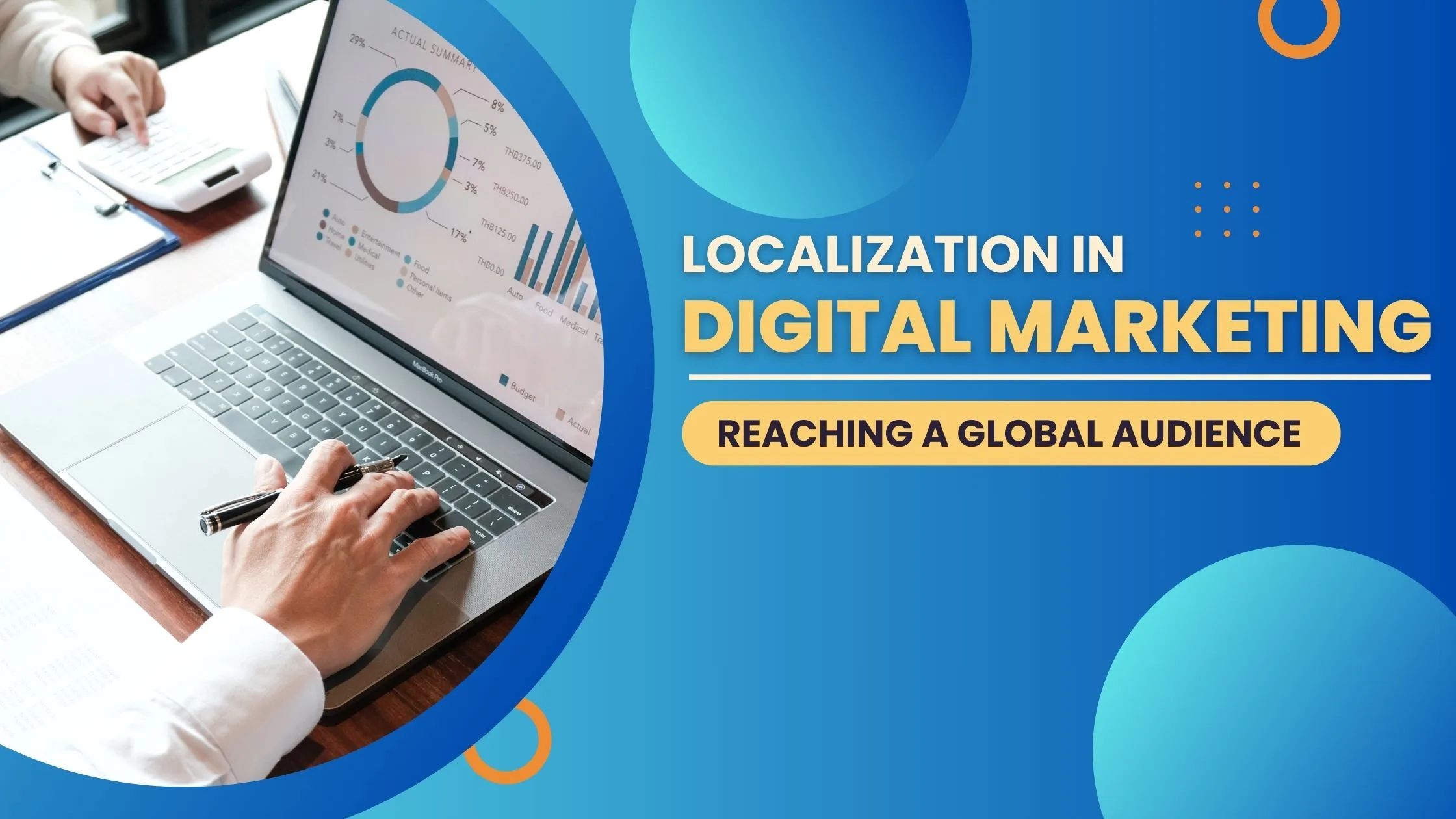Localization in Digital Marketing: Reaching a Global Audience
Are you looking to expand your business and reach a global audience? In today’s digital era, localization is the key to unlocking limitless opportunities. Whether you’re a startup or an established brand, understanding how to tailor your marketing efforts for different cultures and languages can make all the difference in attracting customers from around the world. Join us as we delve into the fascinating world of localization in digital marketing and discover strategies that will help you connect with diverse audiences on a deeper level. Get ready to take your brand global – let’s dive in!
Introduction to Localization in Digital Marketing
As the world becomes increasingly interconnected and technology continues to advance, businesses are able to reach a wider global audience than ever before. This has led to the rise of digital marketing, where companies utilize various online platforms and strategies to promote their products or services. However, with a global audience comes the need for localization in digital marketing.
Localization in digital marketing refers to the process of adapting marketing campaigns and content to suit different cultural, linguistic, and regional preferences. It involves tailoring marketing efforts in a way that resonates with local audiences while still maintaining brand consistency. This is essential because what may work for one audience may not necessarily work for another.
The concept of localization goes beyond just translating text into different languages. It also takes into account cultural nuances, local customs, values, and trends that can impact how a message is received by an audience. For example, colors can have different meanings in different cultures – red symbolizes luck and happiness in China but represents danger or warning in Western cultures.
By implementing localization strategies in digital marketing, businesses can effectively connect with their target audiences on a deeper level and build trust with potential customers. This ultimately leads to increased engagement, conversion rates, and overall success in international markets.
One of the main benefits of localization is that it allows companies to stand out from competitors who may be using generic global campaigns. Localized content shows that a company understands its target market’s needs and values them enough to tailor their messaging accordingly.
What is Localization and Why is it Important?
Localization is the process of adapting a product or service to meet the linguistic, cultural, and technical requirements of a specific target market. In digital marketing, localization involves modifying websites, online content, and advertising strategies to effectively reach a global audience.
The importance of localization in digital marketing cannot be overstated. With the rise of e-commerce and online platforms, businesses have an unprecedented opportunity to reach customers from all corners of the world. However, simply translating content into different languages is not enough to effectively engage with diverse audiences.
Cultural nuances play a significant role in shaping consumer behavior and decision-making processes. Therefore, businesses must tailor their marketing strategies according to the cultural context of each target market. This involves understanding local customs, traditions, values, and beliefs that may influence how consumers perceive products or services.
One major benefit of localization is that it enhances customer experience. By providing content in their native language and incorporating culturally relevant elements, businesses can create a more personalized and relatable experience for their international customers. This leads to increased engagement, trust, and loyalty towards the brand.
Moreover, localization can also improve brand perception in new markets. When businesses demonstrate an understanding and appreciation for local cultures through targeted marketing efforts, they are more likely to be perceived as respectful and trustworthy by potential customers. This can help build a positive reputation for the brand in new markets.
Understanding Cultural Differences
Culture plays a significant role in shaping the values, beliefs, and behaviors of individuals and societies. As the world becomes increasingly interconnected through digital platforms, it is essential for businesses to understand and respect cultural differences in their marketing strategies. This is known as localization – the process of adapting products or content to a specific locale or culture.
One of the key aspects of localization in digital marketing is understanding cultural differences. It involves recognizing that what works in one country may not necessarily work in another due to varying cultural norms, customs, and preferences. To effectively reach a global audience, businesses must have a deep understanding of these nuances.
Here are some important factors to consider when it comes to understanding cultural differences:
1. Language: The first step towards successful localization is language translation. Localizing content into the native language of your target audience is crucial for establishing a connection with them. It goes beyond simply translating words; it also involves adapting phrases, idioms, and expressions that may have different meanings or connotations in different cultures.
2. Communication styles: Communication styles can vary greatly across cultures. Some cultures value direct communication while others prefer indirect communication with more subtle cues and gestures. Therefore, businesses must tailor their messaging accordingly to resonate with their target audience.
Tailoring Content for Different Regions
Tailoring content for different regions is a crucial aspect of localization in digital marketing. As businesses expand their reach to a global audience, it becomes essential to understand the cultural nuances and preferences of different regions in order to effectively connect with potential customers. In this section, we will discuss the importance of tailoring content for different regions and some key strategies for doing so.
Why Tailor Content for Different Regions?
The way people consume information and interact with brands varies greatly across different regions. What works well in one region may not necessarily resonate with audiences in another region. Therefore, it is important to tailor your content to fit the specific needs and preferences of each target market.
Language is one of the most obvious reasons for tailoring content. While English may be the dominant language on a global scale, there are many countries where other languages are spoken or preferred. For example, if you are targeting the Chinese market, it would be wise to have your website and marketing materials translated into Mandarin or Cantonese.
Moreover, cultural differences also play a significant role in how people perceive and respond to marketing messages. For instance, certain colors, symbols, or images that may be perfectly acceptable in one culture could offend or confuse individuals from another culture. By understanding these nuances and tailoring your content accordingly, you can avoid any misinterpretations or negative reactions from your target audience.
Localizing Social Media Strategies
Localizing social media strategies is a crucial aspect of digital marketing when it comes to reaching a global audience. With the rise of social media platforms, businesses have the opportunity to connect with audiences from all over the world and expand their reach beyond their local market. However, simply using the same tactics and content on different social media platforms in different countries may not be effective in engaging with your target audience.
When it comes to localization in social media, one size does not fit all. Each country has its own unique culture, language, behavior, and preferences when it comes to social media usage. Therefore, it is important for businesses to develop a tailored approach for each market they want to target.
The first step in localizing your social media strategy is understanding the cultural nuances of your target audience. This includes their customs, traditions, beliefs, holidays, and even humor. What may be considered appropriate or funny in one country could be offensive or confusing in another. For example, McDonald’s “I’m Lovin’ It” slogan was translated as “I’m Vomiting” in Mandarin which caused an uproar among Chinese consumers.
Another important factor to consider is language. While English may be considered a universal language for business communication, many people prefer consuming content in their native language on social media. This requires businesses to invest in professional translation services or hiring native speakers who understand both the language and cultural context.
SEO and Keyword Localization
SEO (Search Engine Optimization) and keyword localization are two crucial components of digital marketing that go hand in hand when it comes to reaching a global audience. In today’s digital world, where the internet has made it possible for businesses to target customers all over the globe, it is essential to understand these two concepts and how they can be used effectively.
To put it simply, SEO is the process of optimizing your website and content so that it ranks higher on search engine results pages (SERPs). When a user searches for a particular keyword or phrase related to your business, you want your website to appear among the top results. This is where SEO comes into play – by using various techniques such as keyword research, backlinking, and optimizing website structure and content, you can improve your website’s visibility and attract more organic traffic.
On the other hand, keyword localization involves adapting your keywords or key phrases to suit the local language and culture of your target audience. As we know, different countries have different languages and dialects. Therefore, if you want to reach a global audience successfully, simply translating your existing keywords may not be enough. You need to localize them based on cultural nuances and regional preferences.
The Role of Translation Services in Localization
Localization is the process of adapting content and products to meet the specific cultural, linguistic, and functional requirements of a target market. In today’s globalized world, localization has become an essential aspect of digital marketing strategies, allowing businesses to effectively communicate with their international audience and expand their reach.
One crucial component of successful localization is translation services. Translation involves converting written or spoken text from one language to another while maintaining its original meaning and context. In the context of localization, translation services play a vital role in ensuring that all elements of a product or marketing campaign are accurately translated into the local language.
Here are some key ways in which translation services contribute to effective localization:
1. Accurate Communication: The primary purpose of translation services in localization is to facilitate effective communication with the target audience. By translating content into their native language, businesses can effectively convey their message and connect with potential customers on a deeper level. This not only helps build trust but also increases the chances of business success in that particular market.
2. Cultural Sensitivity: Localization goes beyond just translating words; it also involves understanding and respecting local cultures and customs. A professional translation service provider will have native translators who are well-versed in the local culture and can ensure that your content does not unintentionally offend or misrepresent any cultural values.
Case Studies: Successful Examples of Localization in Digital Marketing
Case studies are powerful tools for demonstrating the effectiveness of localization in digital marketing. They provide real-life examples of companies that have successfully implemented localization strategies and reaped the benefits of reaching a global audience. In this section, we will explore some notable case studies that showcase how localization can enhance a brand’s digital marketing efforts.
1. Airbnb: Personalization through Localization
Airbnb is a prime example of how personalized and localized content can drive success in digital marketing. With listings in over 220 countries and regions, Airbnb has an impressive global presence. However, their success is not just limited to availability; it also lies in their ability to tailor their content to suit different cultures and languages.
For instance, when launching in China, Airbnb didn’t simply translate its existing website into Chinese – they created an entirely new platform designed specifically for the Chinese market. This included features such as allowing users to pay with Alipay (a popular e-wallet in China) and integrating local social media platforms like WeChat for seamless sharing among friends and family.
This level of personalization has helped Airbnb establish a strong presence in China, where they now have more than 200 million active users.
Challenges and Tips for Implementing Localization
Localization can bring many benefits to your digital marketing strategy, but it also comes with its own set of challenges. Here are some common challenges you may face when implementing localization and tips on how to overcome them.
1. Language Barriers
The most obvious challenge in localization is the language barrier. When trying to reach a global audience, you need to ensure that your content is translated accurately and effectively into the target language. This can be a daunting task, especially if you are not familiar with the language or culture of your target market.
Tip: Invest in Professional Translation Services
To overcome this challenge, it is crucial to invest in professional translation services. These services have experienced translators who are fluent in both languages and can accurately convey the tone and message of your content. They also have an understanding of cultural nuances, which is essential for creating localized content that resonates with your target audience.
2. Cultural Differences
Another significant challenge with localization is navigating cultural differences. What works well in one country may not be suitable for another due to varying cultural norms and values. For example, humor used in marketing campaigns may differ between cultures, so what may be considered funny in one country could be offensive or confusing in another.
Tip: Conduct Extensive Research on Local Culture
To overcome this challenge, it is crucial to conduct extensive research on the local culture before launching any localized campaigns. This includes understanding their customs, beliefs, traditions, and even pop culture references.
Conclusion:
In today’s digital age, the world is more interconnected than ever before. With the rise of technology and social media, it has become easier to connect with people from all corners of the globe. This presents a huge opportunity for businesses looking to expand their reach and tap into new markets.
One of the key strategies for reaching a global audience is localization. Localization refers to adapting your marketing and communication efforts to cater to the specific needs and preferences of different cultures, languages, and regions. It goes beyond just translation; it involves understanding the nuances and cultural sensitivities of your target audience in order to create content that resonates with them.
The power of localization lies in its ability to break down barriers between businesses and consumers. By speaking directly to your target audience in their own language, you are not only making it easier for them to understand your message but also creating a sense of trust and familiarity. This can go a long way in building brand loyalty and ultimately driving sales.
Moreover, localization allows you to tailor your marketing campaigns according to the local trends and customs in different regions. This means that you can adjust your messaging, visuals, and even product offerings based on what appeals most to each market. For example, while red may symbolize love and passion in Western countries, it is associated with luck and prosperity in China. By taking note of these cultural differences, you can ensure that your marketing efforts are received positively by your target audience.





